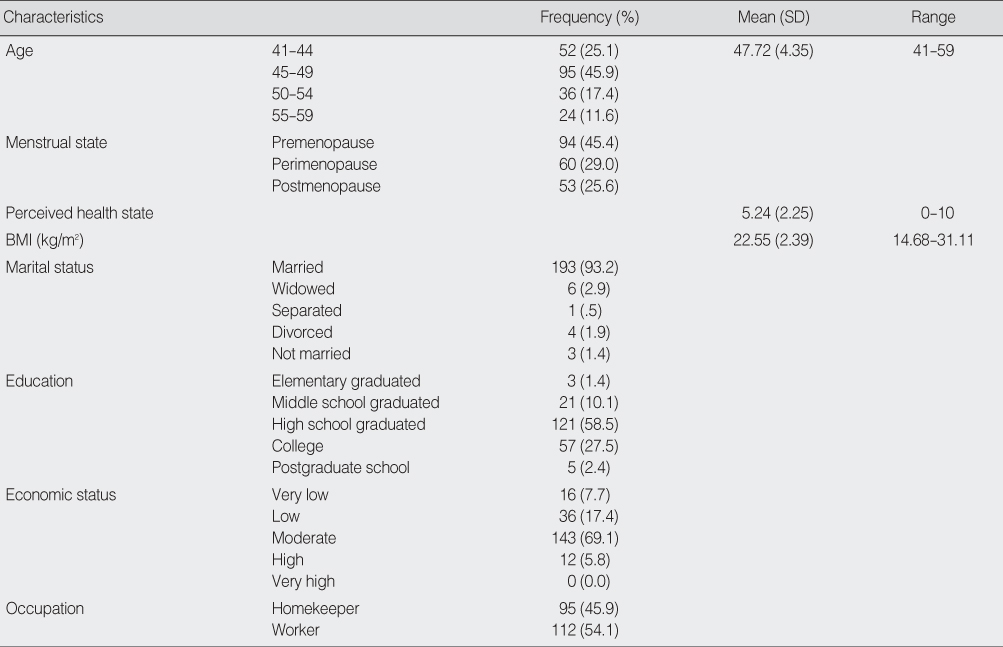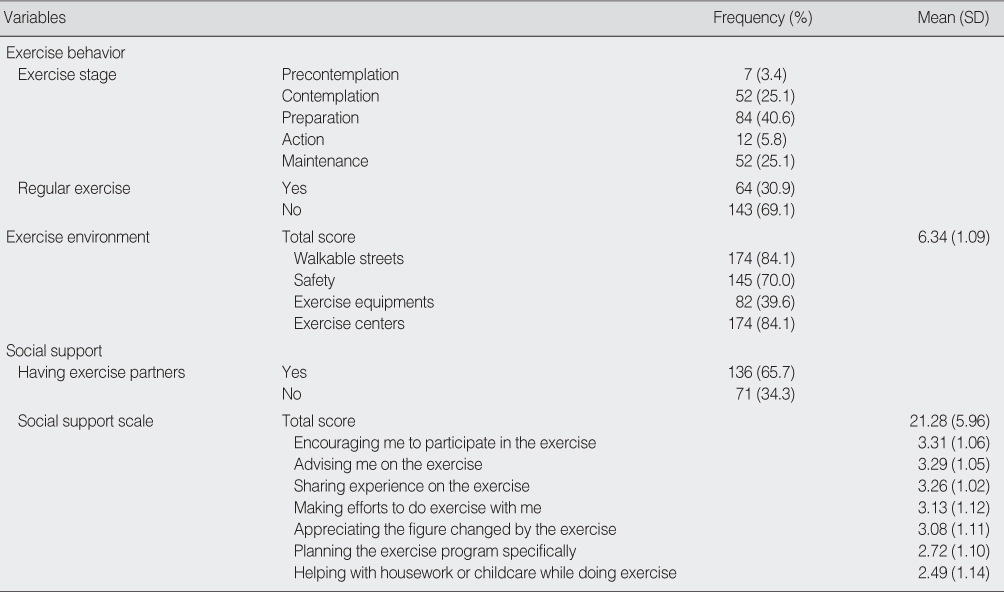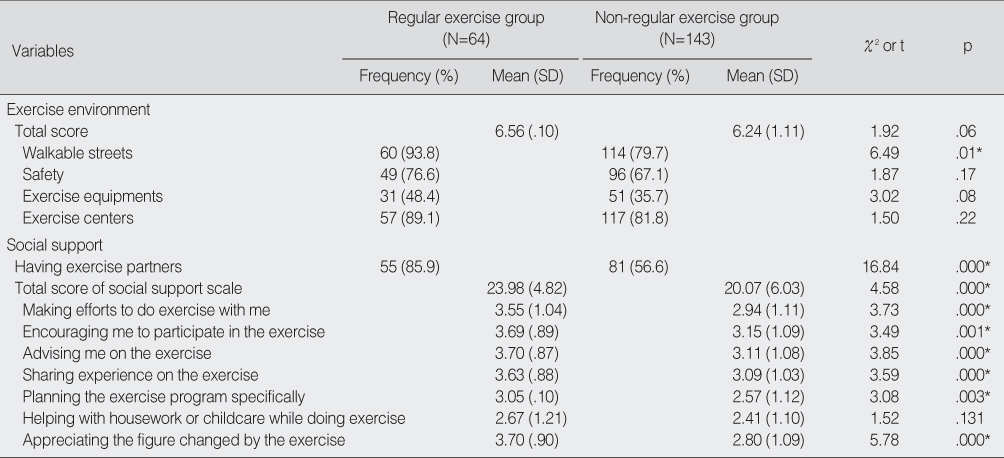Articles
- Page Path
- HOME > J Korean Acad Nurs > Volume 38(1); 2008 > Article
-
Original Article
- A Study on Exercise Behavior, Exercise Environment and Social Support of Middle-Aged Women
- Myoung-Ae Choe, Yang Sook Hah, Keum Soon Kim, Myungsun Yi, Jung-An Choi
-
Journal of Korean Academy of Nursing 2008;38(1):101-110.
DOI: https://doi.org/10.4040/jkan.2008.38.1.101
Published online: February 28, 2008
1Professor, College of Nursing, Seoul National University, Seoul, Korea.
2Full-time Instructor, Department of Nursing, Kkottongnae Hyundo University of Social Welfare, Cheongwon, Korea.
- Address reprint requests to: Choi, Jung-An. Department of Nursing, Kkottongnae Hyundo University of Social Welfare, 387 Sangsam-ri, Hyundo-myeon, Cheongwon-gun, Chungcheingbukdo 363-823, Korea. Tel: 82-43-270-0171, Fax: 82-43-270-0120, paulan@kkot.ac.kr
Copyright © 2008 Korean Society of Nursing Science
Abstract
-
Purpose
- The purpose of this study was to identify exercise environments and social support associated with exercise behaviors in middle-aged women
-
Methods
- Subjects were 207 women aged between 41 and 59 yr in an urban community. The research instruments utilized in this study were exercise stages, exercise environments, exercise partners and social support scale. Subjects were given a self-report questionnaire. Data was analyzed using the SPSS Win program.
-
Results
- The subjects were in the stages of precontemplation (3.4%), contemplation (25.1%), preparation (40.6%), action (5.8%), and maintenance (25.1%). Subjects who engaged in regular exercise were 30.9%. The mean score of the exercise environment was 6.34. The mean score of social support was 21.28, and 65.7% of subjects had exercise partners. The score of the exercise environment was significantly associated with the exercise stage (p=.01). The number of exercise partners of regular exercise groups was significantly greater than that of non-regular exercise groups (p=.00). The score of social support of regular exercise groups was significantly greater than that of non-regular exercise groups (p=.00). The score of social support was significantly associated with the exercise stage (p=.00).
-
Conclusion
- Exercise environments and social support need to be considered in planning exercise programs to improve exercise behavior among middle-aged women.
- 1. Boslaugh SE, Luke DA, Brownson RC, Naleid KS, Kreuter MW. Perceptions of neighborhood environment for physical activity: is it "who you are" or "where you live"? J Urban Health. 2004;81:671–681.ArticlePMC
- 2. Brownson RC, Baker EA, Housemann RA, Brennan LK, Bacak SJ. Environmental and policy determinants of physical activity in the United States. Am J Public Health. 2001;91:1995–2003.ArticlePMC
- 3. Choi JA. Construction of leisure physical activity model in middle-aged women. 2005;Seoul, Seoul National University. Unpublished doctoral dissertation.
- 4. Choi H, Lee EO, Kim BW, Kim IJ. Stage of change for exercise and health-related quality of life in Korean adults. J Korean Acad Adults Nurs. 2004;16:191–201.
- 5. Eaton SB, Eaton SB. An evolutionary perspective on human physical activity: implications for health. Comp Biochem Physiol A Mol Integr Physiol. 2003;136(1):153–159.ArticlePubMed
- 6. Elavsky S, McAuley E. Physical activity, symptoms, esteem, and life satisfaction during menopause. Maturitas. 2005;52:374–385.ArticlePubMed
- 7. Eyler AA, Baker E, Cromer L, King AC, Brownson RC, Donatelle RJ. Physical activity and minority women: a qualitative study. Health Educ Behav. 1998;25:640–652.ArticlePubMedPDF
- 8. Eyler AA, Brownson RC, Donatelle RJ, Brown D, Sallis JF. Physical activity social support and middle-and older-aged minority women: results from a US survey. Soc Sci Med. 1999;49:781–789.ArticlePubMed
- 9. Giles-Corti B, Donovan RJ. Relative influences of individual, social environmental, and physical environmental correlates of walking. Am J Public Health. 2003;93:1583–1589.ArticlePubMedPMC
- 10. King AC, Castro C, Wilcox S, Eyler AA, Sallis JF, Brownson RC. Personal and environmental factors associated with physical inactivity among different racial-ethnic groups of U.S. middle-aged and older-aged women. Health Psychol. 2000;19:354–364.ArticlePubMed
- 11. Kim IJ, Lee EO, Choi HJ. Perceived barriers to exercise of adults: difference by age, gender and residence. J Korean Acad Adults Nurs. 2003;15:193–204.
- 12. Kim KB, Yoo JH, Lee EJ. The experiences of the middle aged women's crisis. J Korean Acad Nurs. 2002;32:305–316.ArticlePDF
- 13. Kim YH, Ha EH, Shin SJ. A study on menopausal symptoms and quality of life in middle aged women. J Korean Acad Nurs. 2003;33:601–608.ArticlePDF
- 14. Kloek GC, van Lenthe FJ, van Nierop PW, Schrijvers CT, Mackenbach JP. Stages of change for moderate-intensity physical activity in deprived neighborhoods. Prev Med. 2006;43:325–331.ArticlePubMed
- 15. Kuh DJ, Cooper C. Physical activity at 36 years: patterns and childhood predictors in a longitudinal study. J Epidemiol Community Health. 1992;46:114–119.ArticlePMC
- 16. Lechner L, De Vries H. Starting participation in an employee fitness program: attitudes, social influence, and self-efficacy. Prev Med. 1995;24:627–633.ArticlePubMed
- 17. Lee DB, Kim SH, Kang YW. The relationships between limited leisure of city-living housewives and their concentration with family. J Korean Phys Educ. 2000;39:820–830.
- 18. Lee MR. Predicting exercise behavior in middle-aged women: extended theory of planned behavior. J Korean Acad Adults Nurs. 2001;13:610–619.
- 19. Lee YM. Process of change, decisional balance and self efficacy corresponding to stages of change in exercise behaviors in middle aged women. J Korean Acad Nurs. 2004;34:362–371.ArticlePDF
- 20. Litt MD, Kleppinger A, Judge JO. Initiation and maintenance of exercise behavior in older women: predictors from the social learning model. J Behav Med. 2002;25(1):83–97.PubMed
- 21. Marcus BH, Selby VC, Niaura RS, Rossi JS. Selfefficacy and the stages of exercise behavior change. Res Q Exerc Sport. 1992;63(1):60–66.ArticlePubMed
- 22. Nishida Y, Suzuki H, Wang DH, Kira S. Psychological determinants of physical activity in Japanese female employees. J Occup Health. 2003;45(1):15–22.ArticlePDF
- 23. Park CS. A model for health promoting behaviors in late-middle aged women. 1995;Seoul, Seoul National University. Unpublished doctoral dissertation.
- 24. Pender NJ. Health promotion in nursing practice. 1996;3rd ed. Stanford, Connecticut, Appleton & Lange.
- 25. Rütten A, Abel T, Kannas L, von Lengerke T, Lüschen G, Diaz JA, et al. Self reported physical activity, public health, and perceived environment: results from a comparative European study. J Epidemiol Community Health. 2001;55:139–146.ArticlePubMedPMC
- 26. Sallis JF, Grossman RM, Pinski RB, Patterson TL, Nader PR. The development of scales to measure social support for diet and exercise behaviors. Prev Med. 1987;16:825–836.ArticlePubMed
- 27. Sallis JF, Hovell MF, Hofstetter CR. Predictors of adoption and maintenance of vigorous physical activity in men and women. Prev Med. 1992;21:237–251.ArticlePubMed
- 28. Wilcox S, Castro C, King AC, Housemann R, Brownson RC. Determinants of leisure time physical activity in rural compared with urban older and ethnically diverse women in the United States. J Epidemiol Community Health. 2000;54:667–672.ArticlePubMedPMC
REFERENCES
Figure & Data
REFERENCES
Citations

- Effects of tai chi, ba duan jin, and walking on the mental health status of urban older people living alone: the mediating role of social participation and the moderating role of the exercise environment
Baoyuan Wu, Guoyan Xiong, Peng Zhang, Xiujie Ma
Frontiers in Public Health.2024;[Epub] CrossRef - Influence of Comprehensive Lifestyle Intervention (LSI) Program on Health, Fatigue, and Quality of Life in Middle-Aged Women
Su-Jin Jung, Seung-Ok Lee, Min-Jun Choi, Jun Heo, Soo-Wan Chae, Baik-Hwan Cho
Journal of Lifestyle Medicine.2022; 12(3): 127. CrossRef - Exploratory study on obesity among middle-aged women in rural areas based on the Socio-ecological Model
Heui Sug Jo, Jong Sun Lee, Su Mi Jung, Yuliya Dronina, Yu Kyung Park, Yang Jun Park
Korean Journal of Health Education and Promotion.2021; 38(5): 1. CrossRef - The Influence of Health Status and Type of Health Management on Depression in Middle-Aged Women
Myung Sill Chung, Yeon Ha Kim, Kyung Choon Lim
Journal of Korean Academic Society of Nursing Education.2018; 24(3): 250. CrossRef - A Structural Analysis for Psychosocial Variables related to Sick Role Behavioral Compliance in Hemodialysis Patients
Young-Mun Cho
Korean Journal of Adult Nursing.2016; 28(4): 415. CrossRef - Factors Associated With Perceived Health Status of Multiracial/Ethnic Midlife Women in the United States
Young Ko, Wonshik Chee, Eun-Ok Im
Journal of Obstetric, Gynecologic & Neonatal Nursing.2016; 45(3): 378. CrossRef - Sex differences in social cognitive factors and physical activity in Korean college students
Jin Yi Choi, Ae Kyung Chang, Eun-Ju Choi
Journal of Physical Therapy Science.2015; 27(6): 1659. CrossRef - Converged Influencing Factors on the Stages of Change of Exercise in Middle Aged Women
Hyea-Kyung Lee, Eun-Hee Shin, Yeon-Kyung Kim
Journal of the Korea Convergence Society.2015; 6(5): 187. CrossRef - Relationship between Expectations Regarding Aging and Physical Activity among Middle Aged Adults in Urban Areas: Based on the Pender's Health Promotion Model
Sung-Hye Cho, MoonKi Choi, JuHee Lee, Hyewon Cho
Journal of Korean Academy of Nursing.2015; 45(1): 14. CrossRef - Effects of Social support based walking program on community
Hyun Kim
Journal of Digital Convergence.2014; 12(7): 357. CrossRef - Construction of a Physical Activity Model for the Elderly
Nam-Hee Kim, Hyoung-Sook Park, Myunghan Choi
Korean Journal of Health Education and Promotion.2013; 30(1): 27. CrossRef - The Comparison between Physical Activity and Health Related Factors of the Korean Male Adult
Jisu Kim, Gyeongnam Lee
Journal of Korean Biological Nursing Science.2012; 14(3): 166. CrossRef - Physical Activities and Related Factors among Low-income Middle-aged People
Seong-Mi Moon
Journal of Korean Public Health Nursing.2012; 26(1): 38. CrossRef - Factors Associated with Active Participation in Health Promotion Programs at a Public Health Center
Yeun-Ju Park, Hyun-Hee Park, So-Yeon Ryu
Journal of agricultural medicine and community health.2010; 35(3): 287. CrossRef - The Effects of Breast Self-examination Program Enriched Environmentally among Healthy Women
Kyung-Yeon Park, So Hee Kim
Korean Journal of Women Health Nursing.2010; 16(2): 105. CrossRef - The Association Between Apolipoprotein E Genotype and Lipid Profiles in Healthy Woman Workers
Kieun Moon, Sook Hee Sung, Youn-Koun Chang, Il-Keun Park, Yun-Mi Paek, Soo-Geun Kim, Tae-In Choi, Young-Woo Jin
Journal of Preventive Medicine and Public Health.2010; 43(3): 213. CrossRef - Health Promotion and Related Factors Among Korean Goose Mothers
Chiyoung Cha
Asian Nursing Research.2010; 4(4): 205. CrossRef - A Study on Exercise Performance and Its Relating Factors in Middle-aged Women
Sung-Jae Oh, Jeung-Im Kim, Young-Ran Chae
Korean Journal of Women Health Nursing.2010; 16(4): 348. CrossRef
Characteristics of the Subjects (N=207)
BMI=body mass index.
Exercise Behavior, Exercise Environment, and Social Supports of the Subjects
Differences in Exercise Environment and Social Support between Regular Exercise Group and Non-regular Exercise Group
*p<.05.
Differences in Exercise Environment and Social Support by Exercise Stages
PC=precontemplation; C=contemplation; PA=preparation; A=action; M=maintenance.
*p<.05.
BMI=body mass index.
*p<.05.
PC=precontemplation; C=contemplation; PA=preparation; A=action; M=maintenance. *p<.05.
 KSNS
KSNS
 E-SUBMISSION
E-SUBMISSION




 Cite
Cite

